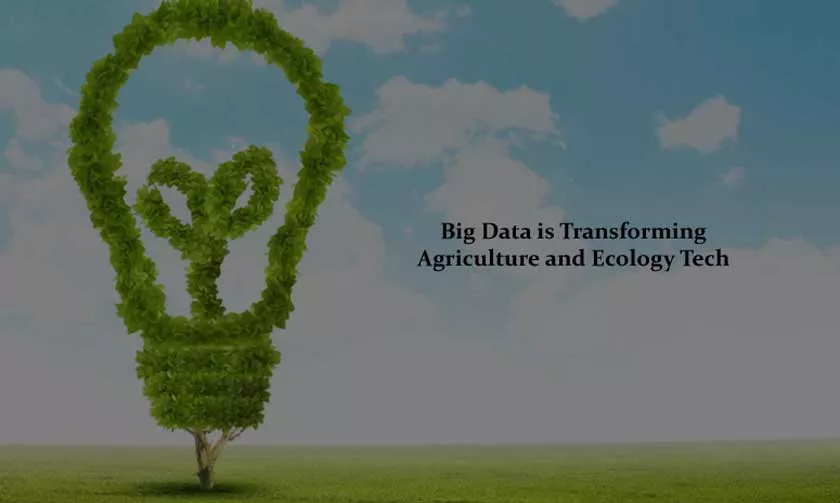Modern technologies allow us to process a colossal array of information in a matter of seconds, which we can use for essential purposes. This phenomenon is called big data. Although the term has been in use since the 1990s, it gained widespread popularity only in 2008, thanks to the Nature magazine editor Clifford Lynch.

Big Data is Transforming Agriculture and Ecology Tech
In the early 2010s, the first solutions for big data analytics began to appear. Today they are trendy in business, where companies use this kind of analytics to improve efficiency. Let’s find out the big data advantages and how we can use these technologies in agriculture.
The IIA director of research Tom Davenport, in his report on a survey of 50 companies, highlighted the following business benefits of big data:
- Speed and efficiency of decision-making. The collection and processing of information are much faster than traditional analytical methods, and at the same time, they are becoming more detailed. As a result, the quality of decision-making is improved.
- Reduced costs. Cloud storage like Hadoop makes it cheaper to store vast amounts of information.
- New services and products. Big data analytics allows companies to identify the actual needs of customers and offer them the best products.
Today, several types of technologies help make big data analytics as efficient as possible. Here are just a few examples:
- Data management. This technology implies structuring and quality control of all data stored in the company.
- Data collection. It helps you analyze large amounts of data by identifying valuable patterns and filtering out unnecessary information.
- Machine learning. It is a particular type of AI that trains a machine to create faster and better analytical models to work with an ever-growing amount of data.
- Text mining. By analyzing various texts from the Internet, for example, blogs, polls, competitor data, you can find new ideas for business development.
Big Data in Agriculture
Around the world, agriculture is confronting global challenges such as climate change and the growing demand for food. Increasingly, industry leaders are turning to new technologies, including big data, for help. According to the latest forecasts, the agricultural analytics market will surpass USD 1 billion in 2023.
How does it help? For example, information obtained from sensors attached to agricultural machinery helps determine soil and plants’ current state.
Data from the Internet and satellites allow us to determine various patterns, such as weather and pricing strategy changes in the coming years.
We can use all the information to deal with pressing problems and set algorithms that prevent them from occurring in the future.
Both large companies and owners of small private farms can improve the efficiency of their business with the help of big data. Here are a couple of ways:
- Thanks to the big data, farmers can analyze rainfall, soil condition, fertilizer quality, and the effectiveness of individual crops. In this way, they can increase their farm yield and profitability.
- Big data helps determine the optimal level of pesticide use, thereby improving product quality and minimizing damage to the ecosystem.
- Big data also enables more efficient use of agricultural machinery. Farmers can monitor its condition to optimize exploitation.
- Finally, big data analytics can help build your supply chain. It is a well-known fact: every year, we throw away almost a third of the food we produce due to ineffective analysis of actual demand and supply. One way to tackle this problem is to shorten food-to-market cycles by optimizing truck routes.
Big Data in Conservation Ecology
Recently, the role of big data has increased in nature conservation. It is most clearly manifested in the use of satellite imagery.
Unlike traditional methods of observing ecosystem changes, the analysis of satellite images allows us to obtain the most critical information from vast territories quickly.
It is also important to note that these technologies are constantly evolving: the resolution of photos is improving, the frequency of images is increasing, and IT technology allows them to be stored on a vast scale.
Moreover, illustrations are becoming more accessible to many users thanks to Terra Bella, DigitalGlobe, Planet, and other companies. NASA has also joined this process.
In 2018, they launched the GEDI (Global Ecosystem Dynamics Investigation) mission to determine the extent of the impact of deforestation on the levels of carbon dioxide in the atmosphere.
One of the areas where satellite imagery is successfully applied is the control of animal population and migration. According to the Duke University researcher David W. Johnston, ecologists will be amazed when they understand the potential of this tool.
Johnston and his students have already successfully used satellite data to study the gray seal population in the Cape Cod Peninsula.
Another example is the team of the biologist Douglas McCauley of the University of California, Santa Barbara investigating wildebeests’ behavior in Tanzania’s Serengeti National Park. Thanks to satellite images, they could track not a few dozen animals but several hundred thousand.
At the same time, according to Nathalie Pettorelli, a representative of the Zoological Society of London, adaptation of scientists, who are mainly accustomed to traditional methods, to new technologies is still underway.
